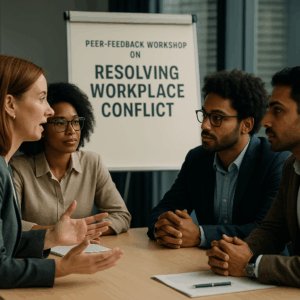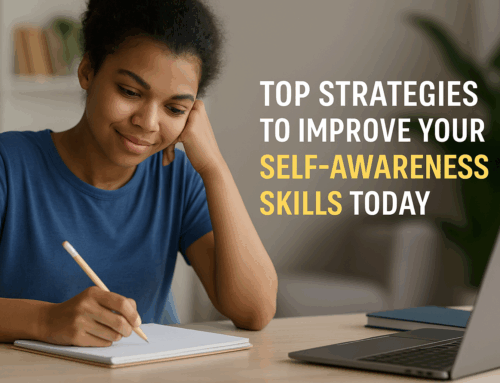A Core Emotional Intelligence Skill
for Academic and Career
1. Emotional Intelligence, Conflict Resolution Skills for the Workplace
Emotional intelligence is the capacity to perceive, understand and manage one’s own emotions, as well as recognise and influence the feelings of others.
This blend of skills plays a critical role in both academic success and career advancement. For students, high emotional intelligence [4] helps navigate the pressures of coursework, group projects and examinations; it fosters resilience, enhances motivation and supports effective collaboration [1].
In professional settings, these same abilities underpin strong communication, teamwork and leadership, making emotionally intelligent individuals highly sought after by employers [2].
Within the domain of emotional intelligence, conflict resolution emerges as a core skill. Whether resolving disagreements over assignment roles or mediating workplace disputes, the ability to manage tensions constructively prevents minor misunderstandings from escalating and preserves positive relationships [3].
Successfully navigating conflict also bolsters trust, encourages open dialogue and fosters a culture of mutual respect; essential ingredients for both high-performing teams and academic cohorts.
Developing conflict resolution does not happen by chance. It builds on foundational competencies such as self-awareness, which helps you recognise your emotional triggers, and empathy, which enables you to understand differing perspectives.
Linking these to practical techniques, active listening, collaborative negotiation and clear boundary-setting, creates a toolkit that serves students during group work and professionals in the workplace alike.
Throughout this article, we will explore how mastering workplace conflict resolution can directly enhance academic performance, build key Behavioural Skills and ultimately unlock greater career opportunities.
2. What Is Conflict Resolution?
Conflict resolution is the process by which two or more parties address a disagreement and arrive at a mutually acceptable solution.
In the workplace, this involves clear communication, empathy and structured problem-solving to restore harmony and maintain productivity [5].
Unlike broader problem-solving, which may focus on technical or procedural issues, conflict resolution zeroes in on the emotional and relational aspects of a dispute, seeking to reconcile differing perspectives rather than simply eliminate a technical obstacle [6].
While “conflict management” often refers to ongoing organisational practices that minimise the frequency or impact of disputes, conflict resolution zeroes in on finding a final remedy for a specific disagreement.
Effective resolution addresses root causes, prevents recurrence and rebuilds trust among colleagues [7].
It may take the form of informal conversations, mediated discussions or formal workplace dispute resolution procedures, depending on the severity and context of the conflict.
Key terms related to conflict resolution include:
- Workplace dispute resolution: Structured methods, such as mediation or arbitration, used by organisations to resolve employee disagreements.
- Conflict management: A broader set of strategies and policies designed to prevent and mitigate conflicts across an organisation.
- Conflict mediation: The use of a neutral third party to facilitate discussion and guide disputing parties towards consensus.
Understanding these distinctions helps individuals select the most appropriate approach. For instance, a quick, informal dialogue between two team members may suffice for minor misunderstandings, while persistent or high-stakes disputes often require more formal mediation.
By developing core interpersonal capabilities, such as active listening, emotional regulation and empathy; professionals enhance their ability to navigate conflicts constructively.
These skills form part of the broader Behavioural Skills that underpin effective conflict resolution and long-term team success.
3. Emotional Intelligence – Conflict Resolution Connection
Conflict resolution hinges on core components of Emotional Intelligence – self-awareness, emotional regulation and empathy, that together create the capacity to navigate disagreements with clarity and composure.
Self-awareness allows you to recognise your emotional triggers and biases before they derail a conversation.
By tracking your internal responses, you can choose a measured reaction rather than an impulsive one. These skills are at the heart of effective Self Awareness Skills development, which form the first step in managing workplace tensions constructively [8].
Emotional regulation builds on that foundation, enabling you to stay calm under pressure and guide discussions toward resolution rather than escalation.
Techniques such as pausing before responding, focusing on breath control, or reframing negative thoughts help you maintain a steady demeanour.
When both parties feel heard and the emotional climate is stable, discussion shifts from blame-casting to problem-solving.
Organisations that train in these Behavioural Skills report lower incidences of recurring disputes and higher team cohesion [9].
Finally, empathy bridges the gap between differing viewpoints.
By actively seeking to understand colleagues’ feelings and underlying concerns, you foster an environment of mutual respect.
Empathy-driven dialogue reduces resistance, uncovers shared interests and lays the groundwork for collaborative solutions—transforming conflicts into opportunities for growth.
Mastering this triad of emotional intelligence competencies directly enhances your conflict resolution prowess and sets the stage for long-term academic and career success [10].
4. Common Types of Workplace Conflict
Understanding the nature of a dispute is the first step towards effective Conflict Resolution.
Broadly speaking, most workplace disagreements fall into three categories: task-based disputes, interpersonal tensions and structural conflicts.
Each type arises from different causes and therefore demands a tailored approach.
4.1 Task-Based Disputes
Task-based conflicts emerge when colleagues disagree over how work should be done.
This can involve:
- Division of labour: Uncertainty or disagreement about who is responsible for specific tasks.
- Resource allocation: Competing claims on limited budgets, time or equipment.
- Procedural differences: Clashes over methods, timelines or quality standards.
For example, a product-development team might argue over whether to prioritise extensive initial testing (to catch defects early) or a faster launch schedule.
Though seemingly technical, such disputes often mask deeper concerns, like perceived fairness or professional recognition [11].
4.2 Interpersonal Tensions
Interpersonal conflicts arise from personality clashes, communication breakdowns or mismatched working styles.
These often manifest as:
- Personality clashes: One individual’s direct style may feel abrasive to a more reserved colleague.
- Miscommunication: Assumptions or unclear messages lead to frustration and mistrust.
- Values and expectations: Differing views on work-life balance or decision-making authority.
Because they involve emotions and perceptions, interpersonal tensions can simmer and undermine team morale if left unaddressed.
Recognising these dynamics early, and applying strong Behavioural Skills such as active listening and empathy, prevents personal issues from escalating into formal disputes [12].
4.3 Structural Conflicts
Structural conflicts are rooted in an organisation’s design, policies or hierarchy rather than individual relationships.
Common sources include:
- Role ambiguity: Unclear job descriptions or overlapping responsibilities.
- Hierarchical friction: Power imbalances or inconsistent decision-making authority.
- Process bottlenecks: Outdated systems that create delays and finger-pointing.
For instance, if two departments believe they both “own” client onboarding, disputes over process ownership can stall progress and damage cross-functional collaboration.
Addressing structural conflicts often requires leadership intervention to clarify roles, streamline processes and reinforce accountability [13].
By correctly identifying the type of conflict, individuals and managers can choose the most effective resolution strategy, be it direct negotiation, formal mediation or process redesign; ensuring that the right conflict resolution techniques are applied to restore harmony and productivity.
5. Key Conflict Management Strategies
Effective conflict resolution relies on a suite of practical strategies that draw on core emotional intelligence competencies. Below, we explore four cornerstone techniques, each grounded in research and proven in practice.
5.1 Active Listening and Reflective Feedback
Active listening involves fully concentrating on the speaker, demonstrating understanding through verbal nods and summarising their points before responding.
Organisations that embrace this approach report up to a 30 per cent reduction in turnover and higher team engagement, as employees feel genuinely heard and valued [14].
To practise active listening:
- Maintain eye contact and use encouraging prompts (“I see,” “Tell me more”).
- Paraphrase the speaker’s message (“So you’re concerned that…”).
- Ask open-ended questions to clarify underlying needs (“What outcome would feel fair?”).
Deploying reflective feedback not only prevents misunderstandings but also fosters trust; an essential Behavioural Skills component in any collaborative environment.
5.2 Managing Your Emotional Triggers
Self-regulation begins with identifying the emotions that most derail your composure, be it frustration, fear or defensiveness.
Leaders who prioritise self-awareness learn to notice physiological cues (elevated heart rate, clenched jaw) and apply techniques such as pausing before speaking or taking a brief breathing break [15].
Over time, journalling these triggers and your responses sharpens your Self Awareness Skills, enabling you to:
- Recognise early warning signs of emotional escalation.
- Implement calming strategies (deep breathing, counting to ten).
- Reframe negative thoughts into constructive questions (“How can we solve this together?”).
5.3 Collaborative Problem-Solving and Win-Win Negotiation
Rather than viewing conflict as zero-sum, collaborative problem-solving reframes disputes as joint puzzles to solve.
Research shows that exchanging information and co-creating solutions leads to more durable agreements and greater buy-in from all parties [16].
To apply this method:
- Define the shared goal (e.g. “We both want the project to succeed on time”).
- Brainstorm multiple options without immediate judgment.
- Evaluate each option’s pros and cons together and agree on a clear action plan.
This approach exemplifies advanced Emotional Intelligence in action, transforming conflict into innovation.
5.4 Setting Boundaries and Maintaining Professionalism
Clear, mutually understood boundaries prevent many conflicts before they start.
Effective boundary-setting involves:
- Articulating your needs and limits (“I’m available for urgent calls between 9 am and 5 pm”).
- Agreeing on communication norms (response times, preferred channels).
- Holding consistently to those agreements.
Studies indicate that teams with well-defined norms experience higher respect, reduced stress and smoother workflows [17].
By combining boundary-setting with empathy and respect, you create a professional climate where disputes are resolved swiftly and constructively.
6. Practical Exercises to Develop Conflict Resolution Skills
Building Conflict Resolution mastery requires hands-on practice.
Below are three targeted exercises you can integrate into training sessions, study groups or team meetings, each designed to strengthen essential Emotional Intelligence competencies.
6.1 Role-Playing Workplace Dispute Scenarios
Set up realistic conflict situations, such as disagreements over task ownership or communication breakdowns, and assign participants to the roles of “employee A,” “employee B” and, optionally, “observer.”
Encourage speakers to use active listening and “I-statements,” while observers note the use of empathy, tone and body language.
After each round, debrief: What strategies worked?
Which Behavioural Skills need further refinement?
This method builds both confidence and competence in a low-risk environment [18].
6.2 Journalling Emotional Responses and De-Escalation Techniques
Following an actual or simulated dispute, ask individuals to journal their emotional triggers, physical sensations (e.g. racing heart) and thought patterns.
Then prompt them to record which de-escalation strategy they applied, deep breathing, pausing before speaking or reframing their perspective, and its effect.
Regular reflection deepens Self Awareness Skills, helping participants anticipate and manage emotional escalation in future conflicts [19].
6.3 Peer-Feedback Workshops on “Resolving Workplace Conflict”
Form small groups of three to five. Each member shares a recent workplace disagreement (anonymously if preferred).
Peers take turns offering constructive feedback:
What communication approach could improve understanding?
Which negotiation tactics might lead to a win-win outcome?
Rotate roles so everyone practices both giving and receiving feedback.
This collaborative format enhances Social Success by reinforcing supportive dialogue, accountability and shared problem-solving [20].
Engaging regularly in these exercises embeds Conflict Resolution techniques into your daily routines, equipping you to handle disagreements with composure, clarity and empathy.
7. Transferring Conflict Resolution from the Workplace to Academia
Group assignments and tutorials in academic settings mirror many of the dynamics found in professional teams. Applying workplace Conflict Resolution strategies in the classroom not only smooths collaboration but also drives better learning outcomes and grades.
Assemble Cohesive Study Teams
Just as you would in a professional project, form groups with classmates whose working styles and strengths complement your own.
Familiarity reduces initial friction and allows the team to focus on substantive issues rather than introductions or mistrust [21].
Establish Clear Roles and Processes
Define responsibilities and deadlines at the outset.
This prevents task-based disputes, such as confusion over who leads research versus who handles presentation design, and reflects strong Behavioural Skills in action.
Use Active Listening and “I-Statements”
When disagreements arise, encourage peers to express concerns using “I feel…” or “I’m concerned that…” language, and practise active listening to paraphrase and clarify their points.
This technique builds empathy and lays the foundation for constructive dialogue [22].
Leverage Emotional Intelligence and Empathy
Recognise when stress or differing expectations fuel conflict.
By drawing on Emotional Intelligence — pausing before reacting and seeking to understand each peer’s perspective, you model the emotional regulation and empathy essential for successful teamwork [23].
Cultivate Social Success
Workshops or peer-feedback sessions focused on conflict scenarios can bolster Social Success, teaching students how to negotiate solutions and maintain positive relationships beyond course deadlines [24].
By translating these workplace-proven approaches into academic practice, students gain not only higher grades but also the transferable expertise that will serve them throughout their careers.
8. Long-Term Benefits for Career Development
Mastering Conflict Resolution delivers enduring career advantages, positioning you as a high-value team member and future leader.
Two key benefits include:
Building a Reputation as a Constructive Collaborator
Consistently navigating disputes with empathy and professionalism earns you a reputation for reliability and composure.
Teams and managers learn to trust your judgement, seeking your input when difficult conversations arise.
This collaborative brand not only enhances your day-to-day working relationships but also signals strong Behavioural Skills and Social Success to potential employers and peers, attributes linked to higher engagement, reduced turnover and accelerated project outcomes [25].
Leveraging Conflict Resolution Skills in Leadership and Management Roles
Leaders who excel at conflict resolution foster open communication, drive innovation and maintain team cohesion under pressure.
By applying structured mediation techniques and win-win negotiation, you guide cross-functional teams through complexity, ensuring goals are met without sacrificing morale.
Organisations increasingly recognise Emotional Intelligence, particularly dispute management, as a core leadership competency, making these skills critical for promotion into supervisory and executive positions [26].
Together, these long-term benefits, rooted in Emotional Intelligence and refined through practice, open doors to strategic roles, enhance your professional brand and sustain career growth.
9. Case Studies and Real-World Examples
9.1 A Student Group Project Resolved Through Structured Mediation
At a mid-sized university, a four-member team encountered a stalemate over choosing between quantitative data analysis and qualitative interviews for their capstone project.
Communication broke down as deadlines loomed, and frustration mounted. To address this, they organised a structured mediation session with their tutor acting as a neutral facilitator.
- Uninterrupted Sharing: Each student spoke for three minutes without interruption, using “I-statements” to express concerns (for example, “I feel uncertain about…”).
- Active Listening: Peers paraphrased each point (“So your main worry is…”) before moving on.
- Collaborative Brainstorming: The tutor guided them through a hybrid-solutions exercise, inviting all ideas, such as combining statistical models with thematic coding, without immediate critique.
This process not only resolved the deadlock but led to a richer mixed-methods design.
The team delivered a balanced methodology, earned top marks and strengthened their trust and cohesion [27].
9.2 A Team Conflict in the Workplace Turned into an Innovation Opportunity
In a tech scale-up, two subteams disagreed over the interface design for a flagship feature: one advocated for a minimalist user experience, the other for an information-rich dashboard.
Initial discussions became competitive, jeopardising the project timeline.
The product manager reframed the dispute as an innovation challenge rather than a binary choice:
- Joint Workshop: Members formed mixed pairs and defined the shared goal, optimising both speed and depth of information.
- Win-Win Negotiation: They generated multiple prototypes, then user-tested each in rapid-cycle simulations.
- Adaptive Solution: Insights from testing inspired an “adaptive interface” that dynamically switches between views based on user interaction patterns.
By leveraging core Behavioural Skills, active listening, empathy and collaborative problem-solving, the conflict became the catalyst for a breakthrough feature, boosting user engagement by 20% and earning internal innovation recognition [28].
10. Conclusion and Action Plan
Effective conflict resolution combines a set of proven techniques, active listening, emotional regulation, collaborative problem-solving and boundary-setting; to transform disputes into constructive dialogue.
Active listening ensures each party feels heard and understood, reducing defensiveness and paving the way for mutual respect.
Emotional regulation techniques, such as pausing before responding or reframing negative thoughts, keep conversations calm and focused.
Collaborative problem-solving reframes disagreements as joint challenges, fostering creative, win–win solutions.
Finally, clear boundary-setting and agreed communication norms prevent many conflicts from arising and maintain professionalism even under pressure [29 [30].
Next Steps: Setting Personal Development Goals and Seeking Mentorship
- Define SMART Goals
– Specify one technique to master each month (for example, practising “I-statements” in weekly team meetings).- Ensure goals are Specific, Measurable, Attainable, Relevant and Time-bound (SMART) to track progress effectively [31]. - Engage a Mentor or Coach
– Identify a mentor skilled in dispute management, ideally someone within your organisation or academic department.
– Collaboratively set objectives for your mentorship sessions, focusing on real-world conflict scenarios. Regularly review and adjust these objectives to sharpen your approach [32]. - Embed Reflection and Feedback
– Keep a learning journal to record conflict situations, applied techniques and outcomes.
– Seek peer or mentor feedback after each key interaction, refining your Emotional Intelligence toolkit over time.
By systematically applying these steps, you will reinforce your Emotional Intelligence, enhance your Behavioural Skills and build a reputation for Conflict Resolution excellence, setting you on a path to academic distinction and career leadership.
References, Sources & Citations:
- Study at UQ. “Why is emotional intelligence important for students?” Published 9 Jun, 2023. study.uq.edu.au
- Purdue Global. “What Is Emotional Intelligence & Why Is It Important to Your Career?” Published c. 1 year ago. purdueglobal.edu
- California Lutheran University. “Importance of Emotional Intelligence for Effective Management.” Published 7 months ago. callutheran.edu
- Wikipedia. “Emotional intelligence.” Updated 4 days ago. en.wikipedia.org
- CMOE. “What Is Conflict Resolution in the Workplace?” Accessed July 2025. cmoe.com
- Verywell Mind. “Conflict Management vs. Conflict Resolution: What’s the Difference?” Published Oct 2022. verywellmind.com
- StatPearls. “Conflict Management.” Updated 2023. ncbi.nlm.nih.gov
- CPD Online. “Emotional Intelligence Conflict Resolution.” Accessed July 2025. cpdonline.co.uk
- TSW. “How to Apply Emotional Intelligence to Conflict Resolution.” Published c. 2 years ago. tsw.co.uk
- Global Mindful Solutions. “How Emotional Intelligence Facilitates Workplace Conflict Resolution.” Published c. 2 years ago. globalmindfulsolutions.com
- Pollack Peacebuilding. “What Is Task Conflict? Definition, Examples & Resolutions.” Published 10 months ago. pollackpeacebuilding.com
- Pollack Peacebuilding. “7 Types of Conflicts in Organizations (with Examples).” Published 10 months ago. pollackpeacebuilding.com
- Conflict Resolution Training. “What Is Structural Conflict in the Workplace and How to Resolve It.” Published 4 months ago. conflict-resolution-training.com
- Psico-Smart Blog. “What role does active listening play in successful conflict resolution?” Published 10 months ago. blogs.psico-smart.com
- Forbes Coaches Council. “Using Emotional Intelligence And Respect To Resolve Conflict in the Workplace.” Published Jul 2024. forbes.com
- ResearchGate. “Information exchange and collaborative problem-solving roles in organizational conflict resolution.” Published 10 months ago. researchgate.net
- The Conflict Expert. “The Role of Boundaries in Conflict Resolution.” Published Nov 2019. the-conflictexpert.com
- Training Course Material. “3 Conflict Resolution Activities with Readymade Role-Play Scenarios.” Published c. 2 years ago. trainingcoursematerial.com
- Day One App. “Emotional Journaling: How to Use Journaling to Process Emotions.” Published c. 2 years ago. dayoneapp.com
- Pollack Peacebuilding. “14 Conflict Resolution Activities for Workplace Team Building.” Published 3.3 years ago. pollackpeacebuilding.com
- American Public University. “Resolving Team Conflict in Your Classroom Projects.” May 2023. apu.apus.edu
- Harvard Professional & Executive Education. “Preventing and Managing Team Conflict.” Aug 2022. professional.dce.harvard.edu
- ResearchGate. “Exploring The Influence of Conflict in Group Work.” Feb 2024. researchgate.net
- MDPI. “Teamwork Conflict Management Training and Conflict Resolution in Higher Education.” 2023. mdpi.com
- Pollack Peacebuilding. “7 Benefits of Conflict Resolution for Organizations of All Sizes” Updated may 9,2025. pollackpeacebuilding.com
- Join The Collective. “unlock the Power of Collaborative Leadership for Effective Conflict Resolution and Team Management” Published 3 June 2025 jointhecollective.com
- Pollack Peacebuilding. “How to Resolve & Manage Conflict at Universities: 6 Strategies.” Published 10 months ago. pollackpeacebuilding.com
- NCBI PMC. “Navigating workplace conflicts and fostering innovative behaviors.” PMC11520117, published 8 months ago. pmc.ncbi.nlm.nih.gov
- Forbes Coaches Council. “Five Conflict Management Strategies.” Published Jun 2017. forbes.com
- Forbes Business Development Council. “Conflict Management Tips: 4 Ways To Navigate Conflict At Work.” Published Jan 2023. forbes.com
- MentorCruise. “How To Set Effective Mentoring Goals.” Published Apr 2022. mentorcruise.com
- 32. TogetherPlatform. “The 9 Most Common Mentorship Goals and Objectives.” Published Jan 2021. togetherplatform.com









